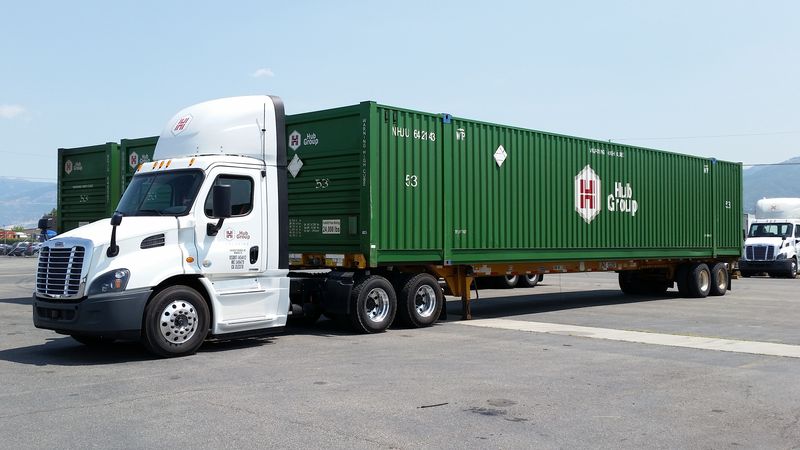Understanding the dimensions and capacity of a dry van trailer is essential for anyone involved in logistics, trucking, or freight transportation, especially if you’re already familiar with what a dry van is and how it works in freight transportation. These trailers come in different sizes and capacities, making it crucial to know how much space you have to work with when planning shipments. This guide will walk you through the standard dry van trailer dimensions, particularly the popular 53-foot trailers, and explain how much cargo they can hold.
Standard Dry Van Dimensions
When it comes to understanding dry van trailers, dimensions play a crucial role in determining how much cargo can be safely and efficiently transported. Dry vans are the most common type of freight trailer used in trucking, forming the backbone of what is known as dry van freight, and their size varies depending on the specific model. The standard dry van trailer, especially the popular 53-foot version with standard 53 dry van dimensions, is designed to handle large loads while fitting into most logistical and regulatory frameworks.
How Long and Tall Is a Dry Van?
In general, dry van trailers come in several dry van sizes, but the most common ones are 48 feet and 53 feet in dry van length. The length of a dry van is crucial as it determines how much cargo it can carry. As for dry van height, most trailers are about 13 feet 6 inches tall, though some variations may differ slightly depending on the manufacturer or region. The height and length are important factors when considering clearance at loading docks, bridges, and other transportation infrastructure.
When fully loaded, these trailers can be quite heavy, making it just as important to understand how much a dry van weighs and costs as it is to know its dimensions for safe and effective freight management.
Dimensions of a 53-Foot Dry Van
A 53-foot dry van is considered the standard for most long-haul trucking operations in the U.S., with 53 foot dry van dimensions that allow efficient loading. It offers significant cargo space, making it ideal for transporting large quantities of goods.
In terms of internal dimensions of a 53' dry van, a standard model typically provides around 53 feet in length, 8 feet in dry van width, and 8 feet 6 inches in height. These measurements give the trailer an internal cubic capacity of approximately 3,800 cubic feet, with the width of a 53' dry van providing optimal pallet arrangement.
Knowing the precise standard 53' dry van dimensions allows trucking companies and logistics providers to optimize their shipments and ensure they are using space efficiently. The 53-foot dry van is versatile enough to carry a wide range of freight, from retail goods to industrial supplies, and is often compared with other trucking options to determine which is best for specific shipping needs.
How Much Can a Dry Van Hold?
When it comes to transporting goods, understanding a dry van's capacity is essential to maximize its use and efficiency. Dry vans, especially the 53-foot versions, offer impressive space for a wide variety of cargo. Below, we’ll dive into the details of how much they can hold in terms of pallets, cubic feet, and weight.
How Many Pallets Fit in a Dry Van?
One of the most common questions about dry van capacity is how many pallets it can hold. A standard dry van with standard 53 dry van dimensions typically accommodates 26 standard-sized pallets, each measuring 48 inches by 40 inches. This is true for a 53-foot dry van, which offers plenty of space to arrange these pallets efficiently. The configuration of pallets, however, depends on the type of cargo being transported and the pallet configuration used (such as single or double stacked). With proper arrangement, a dry van can maximize its capacity for a variety of freight, but it’s important to understand how it differs from drayage or power-only trucking when planning shipments.
Cubic Feet of Storage Capacity
The storage capacity of a dry van is often measured in cubic feet. A standard 53-foot dry van provides around 3,000 to 3,400 cubic feet of space. This measurement is crucial when dealing with freight that doesn't neatly fit into standard pallet sizes. Knowing the cubic footage of your dry van helps ensure that you have enough space for your cargo and that it is packed in an efficient manner. This volume allows for the transportation of everything from electronics to packaged goods, providing a flexible option for many industries.
How Much Weight Can a Dry Van Carry?
The weight capacity of a dry van trailer varies, but a typical 53-foot dry van can carry between 42,000 to 45,000 pounds of cargo, depending on the weight distribution and the trailer’s construction. This weight includes both the cargo and any equipment needed for transport. The dry van's gross weight (the combined weight of the trailer and its cargo) must also be considered to ensure the trailer is within legal limits for road travel. Make sure to account for the total weight when planning shipments to avoid overloading, which could lead to fines or damage to the trailer.






ASK YOUR QUESTIONS